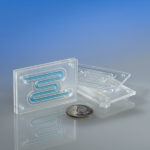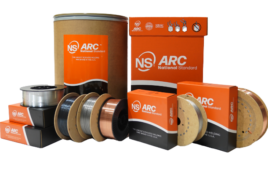Written by Tarick Walton, Global Product Manager
Ultrasonics, Branson Welding and Assembly at Emerson
Conventional ultrasonic welding technology, using single-parameter weld modes, has enabled electronics manufacturers to achieve high levels of assembly quality and reliability. This is particularly true for products built from rigid, molded plastic components.

As next-generation electronic devices become smaller and lighter, ultrasonic techniques are evolving to create repeatable welds atop delicate components.
Ultrasonic welding creates a high-frequency, heat-generating motion between the components to be bonded. It’s been used to join thermoplastics for more than 70 years and has frequently been chosen when parts were too complex or costly to be molded in one piece. Instead, they were molded in multiple parts, which allowed for more efficient and cost-effective welding.
This type of welding uses single, weld-parameter modes such as downforce, distance/collapse, depth, time, or energy to manage weld consistency and high repeatability.
However, controlling weld quality with single-parameter modes becomes more challenging when assembling plastic parts that are:
• Compressible or contain compressible elements
• Inserted into substrates that vary in hardness
• Installed over or contain sensitive metal or electronic components
To assemble hard-to-handle or variable parts, manufacturers have typically had to add an external measuring device to the welder, which allows for the adaptation of a critical weld parameter. This practice adds time, complexity, and cost to the process.
Manufacturers facing next-generation product assembly challenges — from miniaturization to increased electronic contents — require a new range of assembly innovations.
Fortunately, advanced technology is offering just that and eliminating the need for external measuring devices. This new, “dynamic mode” for ultrasonic welding can automatically adjust to respond to part-to-part variabilities and unique materials while avoiding the need to add external measurement or sensing devices.
This technique can safely weld small, thin, or complex plastic parts onto plastic structures directly atop sensors or delicate electronics without damage. It can also weld parts atop plastic assemblies containing compressible internal elements, such as elastomeric seals or cores.
Working in dynamic mode
The dynamic welding mode can monitor, recalculate, and adjust multiple weld parameters in real-time to optimize weld performance within a user-specified target result. This provides users greater versatility and more consistent results by welding in accordance with a design profile instead of a single parameter.
To do so, users must first select the single-parameter weld mode that offers the ideal application results, and then enter two application-specific scores. These act as limits for the dynamic mode activity.

These before-and-after views show the flexibility of dynamic mode in staking a pair of metal washers onto posts. By using the Branson GSX-E1, Elite Precision+’s “dynamic mode,” a consistent weld result was obtained (see image on the right), and even though the application set-up was different and based on the number of metal washers being staked. This is not possible using an alternative weld mode. The dynamic mode stored the material density and reactivity information, enabling it to detect the completion of the stake and dynamically shut the weld down early.
The first score is a material density score that characterizes the hardness or resistance of the material that’s to receive the welded, staked, or inserted part. The second is a weld reactivity score, which impacts the reaction time to achieve the desired density setting. The dynamic mode then monitors each weld cycle and optimizes it in response to specific, part-to-part variabilities throughout the production run.
Here are three examples of how the dynamic mode weld cycle can overcome the limitations of single-parameter weld-mode controls.
1. Sealing a watertight cover over electronics. In this example, a plastic cover must bond gap-free, watertight, and without the cover structure contacting or compressing the sensitive electronics inside the lower component. A single-parameter weld mode (the weld distance or collapse depth) could exert too much pressure on the cover and damage internal device electronics.
By using a dynamic welding mode instead, a manufacturer can optimize the distance/collapse depth mode in each cycle and enable the weld actuator to produce enough collapse depth for a watertight seal. At the same time, this mode detects and avoids a higher resistance that could compress the cover and damage the electronics below the welded cover.
2. Welding a sealed, elastomer-core pin connector. The challenge is to assemble an elastomer-filled, two-way pin connector so that the connecting pins are embedded in a compressible core of elastomeric plastic. The finished plugs must be air and watertight, so the welded-on lid compresses the elastomer around the inserted pins. A flat fit is essential for the lid, but the height of the plug’s elastomeric core may vary by up to 10%.

The new Branson GSX-E1, Elite Precision+ offers the patent-pending “dynamic mode” that can monitor, recalculate, and adjust multiple weld parameters in real-time. This mode enables the welder to manage more complex and varied welds, stakes, and swages by joining parts in accordance with a product’s design profile instead of a single weld parameter.
3. Insert structural pins into a substrate. For this project, it was necessary to insert structural plastic pins into plastic substrates that vary in hardness (such as wood and plastic composites) while ensuring a consistent insertion depth and pull strength. These pins fit into grooves essential for assembly and must provide reliable and consistent strength, despite the variability of the surrounding material and depth and diameter of the drilled holes.
The use of a single-parameter weld mode (e.g., energy or force) to deliver identical force/energy for each insert could result in over-insertion and substrate or insert damage — or under-insertion, misalignment, and pull-out.
By augmenting the energy mode with the material density and using the reactivity scores available in the dynamic mode enabled the welder to measure and moderate the input of weld energy for each insert, aiming for a target condition — a uniform measure of insert resistance — that equates with insert pull strength.
In the dynamic mode, however, the materials density score allows for a weld-by-weld adjustment, which compensates for the varied consistency and height of the plug’s elastomer core. This mode requires that the actuator “sense” or “feel” for the specified amount of resistance (so, the contact with the harder material on the plug’s rim) before beginning the lid weld.
As advances in electronics develop, so do the assembly technologies that ensure a strong and reliable bond. Fortunately, plastic welding now offers more than one way to meet new demands.









Tell Us What You Think!